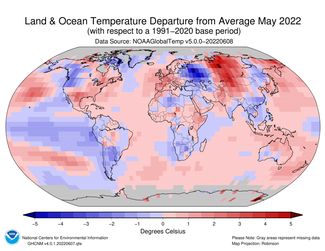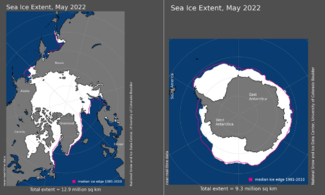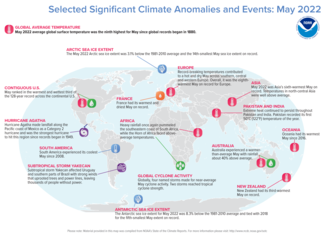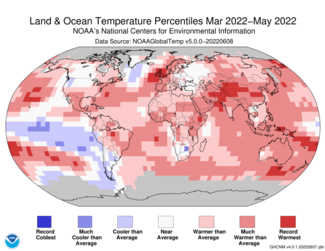Coolest May since 2013 for the globe

Globally, May 2022 was the ninth-warmest May in the 143-year NOAA record. The year-to-date (January-May) global surface temperature was the sixth highest on record. According to NCEI’s Global Annual Temperature Rankings Outlook, it is virtually certain (> 99.0%) that 2022 will rank among the 10-warmest years on record.
This monthly summary, developed by scientists at NOAA’s National Centers for Environmental Information, is part of the suite of climate services NOAA provides to government, business, academia and the public to support informed decision-making.
Monthly Global Temperature
The May 2022 global surface temperature was 1.39°F (0.77°C) above the 20th-century average of 58.6°F (14.8°C), the ninth-warmest May in the 143-year record and the coolest since 2013. May 2022 also marked the 46th consecutive May and the 449th consecutive month with temperatures, at least nominally, above the 20th-century average.
Temperatures were above average in southern and eastern North America, western Europe, central Africa, northern and central Asia, and most of Australia. Temperatures were below average across parts of western North America, much of South America, eastern Europe, parts of northern and southern Africa, and Southeast Asia. Sea surface temperatures were above average across much of the northern and western Pacific, parts of the southeastern Pacific, and most of the Atlantic and Indian oceans. Consistent with La Niña, sea surface temperatures were below average over much of the tropical and southern subtropical eastern Pacific.
Snow Cover and Sea Ice
According to an analysis of NOAA data by the Rutgers Global Snow Lab, Northern Hemisphere snow cover extent during May was 6.93 million square miles, which is about six percent below average. Snow cover over Eurasia was below average while North America was near average.
Arctic sea ice extent in May averaged 4.97 million square miles, which is 158,000 square miles below the 1981-2010 average and the 14th-smallest May extent in the 44-year record, according to an analysis by the National Snow and Ice Data Center (NSIDC) using data from NOAA and NASA. Antarctic sea ice extent for May was 3.60 million square miles, or 322,800 square miles below average, and tied with 2018 for the fifth-smallest May extent on record.
Global Tropical Cyclones
May 2022 produced four named storms globally, including two that reached tropical cyclone strength (74 mph). Both numbers were near normal. The most impactful storm was Hurricane Agatha in the East Pacific, which caused heavy rain and flooding in southern Mexico. Agatha was the first named storm in the Western Hemisphere in 2022 and the strongest hurricane to make landfall along Mexico's Pacific coast in May. No storms formed in the Atlantic during May, which is typical, but this broke a streak of seven consecutive years with a storm before the official start of the Atlantic hurricane season (June 1).
Seasonal Global Temperature
The March-May 2022 global surface temperature was 1.53°F (0.85°C) above the 20th-century average of 56.7°F (13.7°C) and was the sixth-warmest March-May period on record.
The March-May period is defined as the Northern Hemisphere’s meteorological spring and the Southern Hemisphere’s meteorological fall. The Northern Hemisphere spring 2022 temperature was the fifth highest on record. Meanwhile, the Southern Hemisphere autumn temperature was the 10th highest on record.
For a more complete summary of climate conditions and events, see our May 2022 Global Climate Report.








